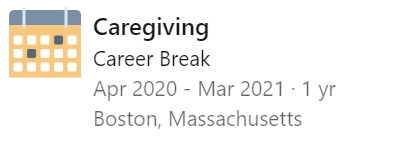You’re looking for your next great hire. As you’re browsing relevant profiles on LinkedIn, you stumble across one candidate with an… unusual work experience:

Not your expected job title. Or, a familiar company name.
Instead, a career break.
Employment gaps are not something new. But highlighting them online hasn’t been what recruiters recommend. This is changing now, and you’ll likely start seeing more entries like these, thanks to a feature that LinkedIn recently rolled out. People have the option to add career breaks to their profiles and, this way, explain why they’ve taken time off from work.
You may wonder why people would want to highlight their employment gaps in a competitive job market.
Attitudes and assumptions about resume gaps have started to shift. Employers are more open to candidates who have taken time away. LinkedIn’s new feature is a reflection of this change and is a way of allowing people to give context to their career breaks.
But this hasn’t always been the case.
Why people are afraid to talk about a resume gap
Historically, resume gaps and career breaks have been red flags. And some hiring managers are still nervous about considering candidates with gaps in their careers. Even subconsciously, employers may be mentally dinging applicants for taking breaks from work.
It can be easy to assume the worst. For instance, “someone who’s stayed out of the workforce for a while has outdated skills.” Or, “someone who quit their job to travel for 6 months isn’t stable and their behavior will be a pattern going forward.”
These concerns may seem valid at first sight. But they’re just that: assumptions.
You don’t know for sure whether candidates have the necessary skills for the job unless you evaluate them during an interview or through an assessment. And you can’t tell whether a candidate is generally flaky because at some point in their career they went on a 6-month trip.
Removing the stigma from career breaks
According to recent research from LinkedIn, 62% of employees have taken a break from work. And the reasons for most of these gaps don’t stem from a lack of loyalty or dependability.
The top reasons people cite for taking time away from their career are to care for family (things like raising children or taking care of a sick relative) and layoffs. Other reasons may include personal or professional development, travel, or personal health.
Whether the reason for an employment gap is driven by personal needs and interests (e.g., someone might be suffering from burnout and wants to prioritize their mental health), or external factors (e.g., a company is making mass layoffs due to the economical crisis), career breaks are not decisive of a person’s skills and potential.
Eliminating arbitrary assumptions and approaching people’s work histories with curiosity instead will benefit your organization in several ways.
Being open to all qualified candidates helps so that you:
- Don’t miss out on finding the strongest candidate for the job.
- Give all candidates equal opportunities at work and support diverse teams.
- Find top talent in the wake of The Great Resignation.
Resume gaps can be an asset
We’ve seen why career breaks shouldn’t be red flags when evaluating candidates. And why you shouldn’t outright reject those with employment gaps in their resumes. But, more than that, could career breaks give employees an edge?
For example, many individuals use their time off to learn new skills and pursue their career goals. Or, to recover and recharge after a stressful situation or illness.
Employees returning to the workforce are often renewed and energized after a productive break. The energy, not to mention strengthened skills, they bring with them can influence productivity and positive attitudes across your organization.
Ready to welcome your new hires?
Deliver a great onboarding experience with TalentLMS.
The training platform that users consistently rank #1.
How you can support employees re-entering the workforce
Successful career paths are not always linear. People change jobs for many different reasons. They may even move to totally different fields. Instead of trying to fit employees into pre-defined boxes, be open to the right candidate by focusing on people’s potential.
Take a good look at what a candidate brings to the table. For instance, people who come from a different industry might bring transferable skills that are missing from your current team. Or, someone who’s been out of work for a while could come full of energy and fresh ideas.
The best course of action is to help support employees as they come back to work. Here are five tips on how you can make the transition back to full-time work smooth and productive.
1. Evaluate employment gaps instead of making assumptions
Take the time to assess the situation rather than dismissing job seekers with employment gaps immediately. For example, a break from work that occurred five years ago isn’t relevant and likely has no bearing on this job.
On the other hand, you might want some explanation about a current gap of several years. Be open to hearing the reasons for the break as you ask about this period in their resume.
2. Make your interview questions inclusive
Ask about past job experiences in a way that takes potential career breaks into account. And ask without judgment. Instead, be objective and curious. Inquire about reasons for leaving a job and accepting the next position, just as you would with any candidate. Then listen for people’s motivations.
Talk to candidates about their experience while on break and how it might contribute to their success in the new role. Try asking what they learned and how their time away from work affected their career goals.
3. Consider a candidate’s full breadth of experience
Identify the abilities needed to succeed in the role you have open, and then look at those exclusively. Every candidate had a work history prior to a gap and will often have learned new skills or refined existing talents during their time away.
Focus on the core competencies needed for the job as you evaluate candidates to get a full picture of their potential in the role.
4. Recognize the value of soft skills
Even if an employee didn’t spend their time away from work actively working on career development, they likely gained skills that will benefit your teams and your organization.
Someone who spent the time caring for children or another loved one, or who took the time to recenter and rethink goals and priorities probably honed skills like empathy, communication, and adaptability.
These types of soft skills are essential in the workplace. They’re an indication of people’s ability to work with others, and employees who are adept at them tend to be more satisfied and productive at work.
5. Evaluate new hires’ training needs
Someone who stepped away from full-time work for a while might have different training needs than a candidate with a continuous work history. Rather than enrolling them in standard training, gauge whether they need a refresher or some upskilling.
For instance, if technology or industry shifts have changed things since their last job, enroll them in a course to bring them up to speed.
Do a skills gap analysis to help you understand what individual employees and teams need to learn. Then base your training strategy around your findings to support them in their career development.

Keep an open mind when hiring
Whether someone decides to disclose a resume gap (on LinkedIn or elsewhere) is a personal decision. When meeting candidates, be discreet about situations that might be sensitive.
The best way to keep things professional and find the most qualified candidates is to focus on skills and professional interests, not on what people have—or haven’t—done in the past. When you emphasize talent and potential, you build an inclusive process. And you get one step closer to finding that great next hire for your team.
